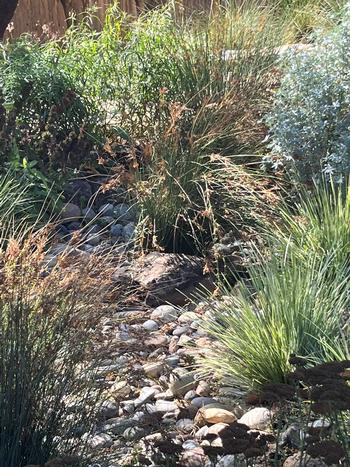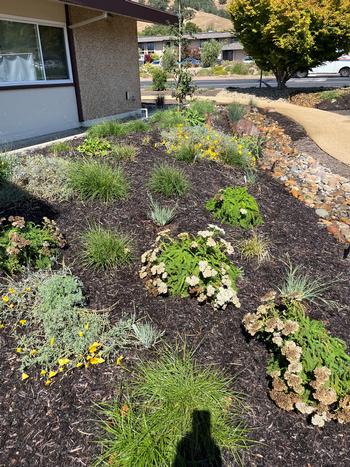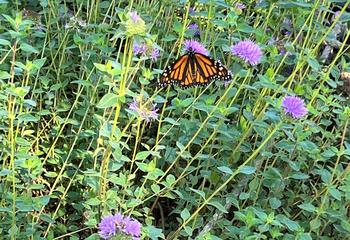Fire-smart landscaping and Earth-friendly gardening on display in Marin
-
Julie McMillan
-
Fire-smart landscaping and Earth-friendly gardening protect your home, strengthen your defensible space, and enhance our planet. For inspiration, visit Marin’s demonstration gardens to see these principles on display.
 A rock swale allows rainwater to percolate into the soil instead of running off at the Fairfax Library. Photo: Julie McMillan
A rock swale allows rainwater to percolate into the soil instead of running off at the Fairfax Library. Photo: Julie McMillanFire-smart landscaping (FSL) includes:
- Thoughtful design: 5’ of hardscaping and noncombustible materials surrounding your home and other structures (Zone 0); vertical and horizontal space via plant placement and pruning; individual plants and groups of plants separated with horizontal space.
- Regular maintenance: no dry or dead wood, dry grasses, and leaf litter; plants pruned creating horizontal and vertical space around structures and throughout your garden; removal of lower vegetation (ladder fuel) that would move fire into taller plants and trees; appropriate mulch (avoid highly flammable gorilla hair).
- Careful plant selection: native plants to attract pollinators and use less water.
Earth-friendly gardening (EFG) builds and protects the soil; uses native plants encouraging biodiversity; conserves water mitigating climate change; and creates habitat protecting living creatures.You can see examples of FSL and EFG at these Marin demonstration gardens, open to the public:
- Novato Fire District Station 63, 65 San Ramon Way (at San Marin Drive): Funded by the Marin Wildfire Prevention Authority (MWPA) and overseen by Mike Swezy, retired Vegetation Management Program Manager, this resilient garden follows FSL. Installed in mid-2023, plants are 5’ from the station and plant islands are separated by hardscape or rock mulch. Native plants provide a pollinator habitat and use less water. The garden includes a rain garden and dry creek, and organic mulch. Plants are grouped according to their water needs, using primarily drip irrigation. Consideration was given to how big plants will get at maturity. Signs identify the plants.
 Native plants and appropriate mulch create a sustainable garden at Station 63 in Novato. Photo: Julie McMillan
Native plants and appropriate mulch create a sustainable garden at Station 63 in Novato. Photo: Julie McMillan - San Rafael Community Center, 618 B Street: Calvin Schrader, San Rafael Fire Department’s Vegetation Management Specialist and Certified Arborist, led the development of the FSL garden, installed in 2023 thanks to MWPA funding. No organic material is used in Zone 0; rock or other appropriate mulch is incorporated; plants are separated and with no ladder fuel. Junipers were removed (per San Rafael’s ordinance) and replaced with native, drought tolerant, and/or pollinator friendly plants using primarily drip irrigation. This is a low-maintenance garden needing care only four times/year. Signs should be posted to explain how residents can easily enhance their defensible space to reduce risk.
- Sleepy Hollow Community Center, 1317 Butterfield Road, San Anselmo: Tom Finn, Sleepy Hollow Fire Protection District (SHFPD) Board member, spearheaded the garden’s design and installation to demonstrate FSL to the public. Completed in early 2024 thanks to SHFPD funding, it includes a 5’ noncombustible zone around the center, islands of low maintenance plants, no fuel ladders near trees, and adequate horizontal and vertical spacing. Plants were chosen for low water use and climate adaptation. It includes a rain garden and swales to improve soil structure. Regular monthly maintenance is performed. Signs explain the features.
- Fairfax Public Library, 2097 Sir Francis Drake Blvd.: Margaret Miles, Branch Manager, led the 2022 transformation of a vacant area into a serene extension of library space, thanks to community, donor and Measure A support. The garden follows EFG, using natives to create a habitat for pollinators, and includes milkweed for monarchs. The design encourages rainwater to enter the soil slowly, with permeable pathways and a swale to capture water from the library’s roof, directing it to the nearby creek. Consistent with FSL, pathways and rock walls separate planting beds, no ladder fuels exist, appropriate mulch is used, and regular weekly maintenance is done.
 A monarch butterfly feeds on native plants at the Fairfax Library. Photo: Julie McMillan
A monarch butterfly feeds on native plants at the Fairfax Library. Photo: Julie McMillan - Novato Fire District Headquarters, 95 Rowland Way: This garden uses FSL to show how commercial landscapes can be better protected from wildfire. EFG examples include replacing thirsty lawns with drought resistant plants that support diversity, including low-mow fescue and milkweed, a rainwater swale and drip irrigation. Expected to be completed this spring, and also MWPA funded, signs will identify native plants that should be available in Marin.
For more FSL inspiration, please watch https://www.youtube.com/watch?v=kUI6hUY9Nq8; for EFG, please watch https://www.youtube.com/watch?v=ChLffQ3Subs&t=21s



